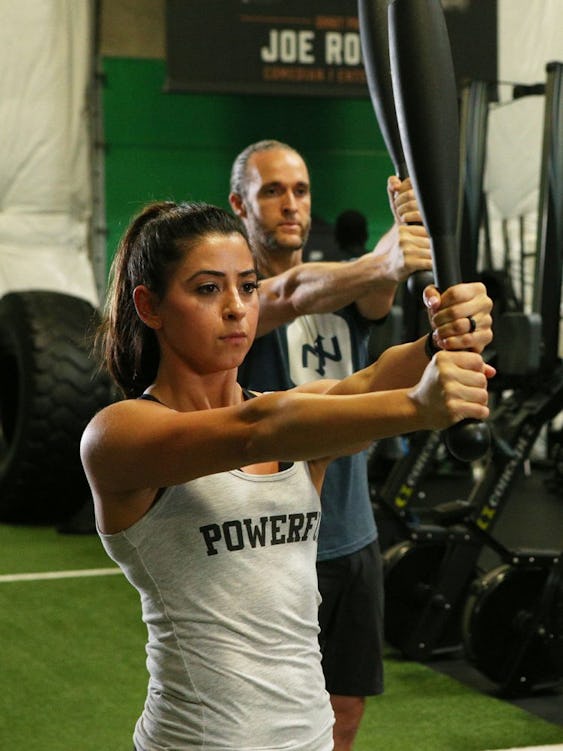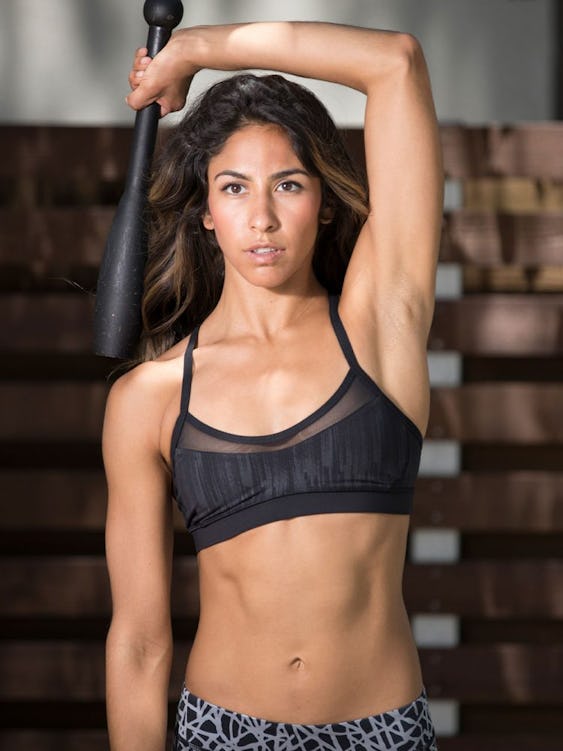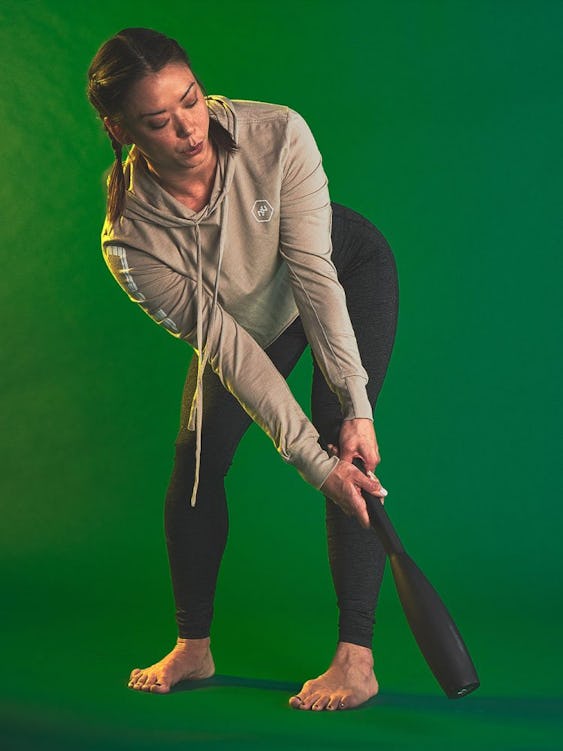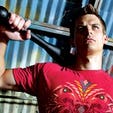If you grew up in the 80s, your introduction to the club as an exercise tool was via pro wrestling’s Iron Sheik. The bald, mustached Iranian would cut promos in which he’d heave two heavy wooden bludgeons overhead and swing them, challenging any pitiful American jabroni to match his reps. While it was good entertainment, the Sheik’s feat of strength was also legit. Prior to his run as one of sports entertainment’s most memorable heels, “Sheiky” was an elite amateur wrestler who did in fact train with clubs—and he wasn’t alone. The club has been helping athletes improve strength and mobility for centuries.
The steel club—the ultimate evolution of the age-old club tool—may be the best training implement you haven’t tried. Here’s what you need to know to start implementing it in your workouts.
What Is A Steel Club?
The club is an offset-loaded weight-training tool, often called a leverage-challenge tool, that works similarly to a kettlebell or steel mace. The bulk of the club’s weight is set at a distance from its handle, making it difficult to stabilize and control. Because of this design, the club lends itself to rotational movements better than perhaps any other piece of equipment (which we’ll discuss in depth further down). Clubs range in length from about one foot to a little more than two feet, and generally come in weight increments ranging between five and 45 pounds.
“The club was our first tool and our first weapon, going back to pre-historic times—think, caveman,” says Shane Heins, Onnit’s Director of Fitness Education, and a steel club coach. “It helped us hunt and fight. People figured out that swinging a club increased the torque on it, and that increased the force it could strike with and the damage it could inflict. So armies learned to swing clubs in battle.”
Over time, warriors realized that swinging clubs—and maces, which developed the same way—strengthened their bodies, and they began formalizing club and mace use for sports training and fitness purposes. Every continent had its own version of the club. To this day, some still call the tool an Indian club, or Persian club (sometimes referred to as a “meel”), as the Indians and Iranians (not least of all the Iron Sheik) did so much to popularize it. In modern times, martial arts fitness expert Scott Sonnon has perhaps been the club’s most vocal champion, helping to spread awareness of club training in the Western world with the popularity of his Clubbell® line over the past 20 years.
Traditionally, clubs were made of wood, but that made progressing to heavier weights problematic. To get a heavier club, you had to upgrade to a bigger piece of wood, making the club cumbersome and difficult to travel with. Due to their greater density, modern-day steel clubs offer heavier weight in a more compact size.
What are the Benefits of Steel Club Training?
As with the kettlebell, steel mace, or any other tool where the weight is offset from the handle, the club presents a number of challenges that you can’t get to the same degree with more conventional equipment. It also has a few features that make it unlike any other implement you can use.
Training with the steel club helps you…
1. Build Core Strength
Kettlebells are praised for promoting core strength due to their offset load. The weight is positioned at a distance from the handle, so it’s harder to stabilize, and your body must call on numerous muscles to keep you in alignment. The club takes this to the next level, as the weight is displaced even further at the end of a long lever.
Imagine holding a heavy weight right in front of your chest. It’s close to your center of mass, so you have about as much control over it as you possibly can. Extend the weight away from you, however, and you’ve reduced your leverage advantage. Now it’s harder to lift the load, especially in different planes (say, in a circular fashion as opposed to straight up and down). All club exercises put you at a significant leverage disadvantage, which is bad for making workouts feel easy, but great for activating muscle—especially in your abs and throughout your back.
2. Build Rotational Strength
The leverage disadvantage and shape of the club really feed into its greatest feature—allowing you to train rotational movements.
“Our body works in rotation all the time,” says Heins. For example, swinging a bat, throwing a ball, lifting heavy groceries out of your car, or wrestling with your kids. Some of the best steel club exercises are swinging and spiral patterns that force you to stabilize your body over a long range of motion, and develop power in the rotary plane.

“We also need to be able to resist rotation when it isn’t wanted,” says Heins. “When you’re walking, and you pick one foot up, forces act on it to try to twist it in one direction or the other. When you’re squatting with a barbell, you think you’re going up and down, but there’s rotational force acting on your shoulders, spine, hips, knees, and feet. The club highlights this resistance, and it helps you create greater stability.” Because of its dimensions, doing something as simple as a squat while holding a club is difficult to accomplish without bending or twisting to one side (rotation). But, over time, you’ll learn to move in exactly the planes you want, and the resulting stability will translate to other exercises and athletic movements.
Similar to unilateral exercises, “the club also shows you which of your sides is stronger,” says Heins, “so you can begin to correct the imbalance between the left and right halves of the body.”
3. Build Grip Strength
When you train rotation, you create centrifugal force. As a lever moves around an axis, it wants to pull away from that axis and move outward. In addition to having a thick handle and an offset load, the club is tough to grip because it wants to fly out of your hands when you swing it. “The steel club is great for building a grip that’s really alive,” says Heins. “You can’t just clamp down on it like you do a barbell before a 500-pound deadlift. Wherever you’re holding or moving it, the club is always pushing down or pulling away from you, so you need the dexterity and articulation and sensitivity, in combination with appropriately applied tension, to hold on and control it.” With this in mind, imagine how club training could help a grappler who needs to hang on to an opponent’s gi, a construction worker who hauls heavy materials up a scaffold with a rope, or a fisherman trying to reel in a fighting marlin.
“When you use a club, you have to feel the load transition from between your thumb and forefinger to the pinky and palm of your hand,” says Heins. “The information it sends to your central nervous system is constantly changing.”
The steel mace works the grip in a similar fashion, but the club is harder to hold on to. The handle is shorter, giving you less surface area to grasp. It’s easy to regress the challenge on a steel mace exercise by holding the handle nearer to the ball on the end, or widening your grip, which increases your control. But the load on the club is elongated, and more offset. You have a lot less handle to spread your hands apart on, and gripping the fat end totally changes the nature of the load. It can sometimes feel like your only option is to hold on for dear life. Sound scary? Take it slow, and it’s not as hazardous as you may think. (See Steel Club Safety below.)
4. Decompress Your Joints and Tissues
Most weight-training exercises tighten your body up, literally. Think of what happens to your spine when you do a back squat: the bar rests on your back, shoving your vertebrae closer together. When you press heavy weights, your shoulders and elbows get squeezed. Continually compressing your joints and shortening the muscles that act on them can lead to pain and loss of flexibility, but the steel club can help to alleviate both.
“You have to pull back on the club a bit as it swings,” says Heins, lest you want the centrifugal force to rip it out of your hands. “That creates some traction in your wrists, elbows, and shoulders, which allows fluid to pass through them, helping recovery. You can strengthen a joint with traction just like you can with compression. Pulling it apart makes the muscles and connective tissues work to hold the joint together, and it’s a nice counterbalance to compressive forces you get in your other training.”
Heins says to think of club training like an accordion. “If you squeeze it, you’re only getting half the music. You have to pull the ends apart again to play a song.”
Traction and rotation also have the effect of helping your muscles into new ranges of motion they wouldn’t otherwise explore. Look at a pullover exercise (see the workout below) with the club, in which you hold it vertically and lift it over your shoulder and behind your back in an arcing motion. The weight of the club will help to stretch your triceps, lats, and shoulders as it moves downward behind you. At the same time, holding your ribs down with your core tight to maintain good spine and hip alignment trains your core. You get stretching and strengthening in one movement. How’s that for training economy?
Big weightlifters and powerlifters often report that working the club into their routines helps to open up their shoulders and backs, adding longevity to their competitive careers and easing aches and pains.
5. Get More Out of Light Weight

The handle, the offset load, and the rotational nature of club training make it virtually impossible to use heavy weight, and that’s perfectly alright. If you’re expecting a 10-pound club to feel like a 10-pound dumbbell, get that thought out of your head right now.
“The top-end weights we work with are 35 pounds,” says Heins. “That’s super heavy for club training, but it’s still only 35 pounds of overall load, so even when you get strong on the club, it isn’t hard to recover from. It’s certainly not like recovering after a one-rep max squat with 400 pounds.” Heins notes that doing a long session of club training might leave you mentally zonked, similar to how you’d feel after taking a final exam, because the club requires so much nervous system activation. But it’s too light to leave you physically wrecked for days. For athletes who need to compete frequently, it’s helpful to have a tool that lets them train hard and bounce back fast.
Light weight also makes clubs highly portable. If you’re planning a road trip that will take you away from your gym, clubs can fit easily into the car, providing you with a workout you can do anywhere from a hotel room to an empty parking lot.
6. Make Training Fun!
“I’ve taught training certifications for the club all over the country,” says Heins, “and every time people walk in and pick up a club for the first time, it’s always funny. They think it’s going to feel like a baseball bat or a bowling pin, and then you watch them have to put it down right away because they realize they can’t control it. They take a step back, and then try again.”
To say club training provides a novel workout experience is a given, but it also taps into a primal instinct in us all that’s inherently fun. Clubs can even be used for creative expression. As you master club exercises, you can begin to transition from one to the next seamlessly, creating what’s known as a flow. There’s no wrong order or movement, per se, you just move gracefully from one position to the next, working your whole body in the process. Workouts then become more like warrior dances than weight training.
What Club Should I Buy?

As mentioned above, steel clubs are denser than wood, so they offer easier handling for a wider array of loads (plus, they take up less space). We recommend starting with steel that has a powder-coated handle. Some club handles have knurling (rough texture, same as you see on barbells), which makes for an easier grip, but they can tear up your hands over time—especially if you do a lot of swinging, where the club is pulling away from you with centrifugal force.
Other clubs have handles that are completely smooth, which Heins says presents an even worse problem. “When you sweat, the handle becomes slick,” he says, “which can turn the club into a missile.” The powder coat on Onnit’s clubs provides just enough friction for the club to change positions in your hand without you losing control of it, and it won’t chafe your palms in the process. Additionally, a club should have a knob on the end of its handle—where the pinky end of your grip gets firm purchase—to help stop your hand from sliding back off it.
Heins recommends men start with a pair of 15-pounders and a single 20 or 25-pound club, and says most women will do well with one pair of 10 pounders and a single 15 or 20-pound club. Most of your club training will be done using both hands on one club to start, as this provides the greatest stability. As you progress, you’ll find that exercises done above the waist (such as presses and pullovers) are hardest when utilizing a club in each hand. Those that are done below the waist (swings and leg drivers) are easier when done with a club in each hand versus two hands on one.
How To Warm Up For a Steel Club Workout
Use the following warmup drills to increase mobility and prepare your body for training. Perform 5 reps for each exercise in sequence, and repeat for 3 total rounds.
1. Kneeling Spinal Wave (See 00:42 in the video below.)
2. Kneeling Arm Thread (02:17)
3. Kneeling Hip Flexor Twist (03:43)
4. Clasped-Hand Elbow Rotation (04:45)
5. Pullover Spiral Down (06:35)
3 Steel Club Exercises You Have to Try
Experiment with steel club training by incorporating the following exercises into your workouts wherever you see fit. The spiral lift around is great for improving shoulder mobility, and can help to stretch the wrist flexor muscles, which can cause elbow pain when tight. That makes it a good choice before an upper-body training session as part of your warmup, or after a workout to help you lengthen the muscles again.
The side pullover opens up your shoulder and lat, and helps you maintain a tight core position, making it a natural for inclusion in any kind of ab training you do. Lastly, the front swing can be used anywhere you would normally do a kettlebell swing or other deadlift/hinge movement. Suggestion: try it as a finisher at the end of a session, combining short rest periods and high reps to get your heart rate soaring (once you’re experienced and familiar with the movement, that is).
Directions: In your first session, take it slow, and focus on your technique so that you learn the exercises correctly. Perform each for time rather than reps, starting with 30 seconds. So you’ll do reps for 30 seconds straight and then rest. On the spiral lift around and side pullover, work for 30 seconds on one side, and then switch sides and repeat. Perform 3 to 5 sets for each movement.
Spiral Lift-Around
Step 1. Stand with feet between hip and shoulder-width apart, and hold a club at your side in your left hand. It should point vertically to the floor below. Tuck your tailbone so that your pelvis is parallel to the floor, brace your core, and squeeze your glutes. Draw your shoulders down and back—think “proud chest.” Maintain this body position throughout the exercise.
Step 2. Begin raising the club straight up in front of your body, pulling from your elbow and allowing the weight of the club to bend your wrist and stretch your forearm. Let the weight of the club pull down as you continue moving the club around the back of your head, and lower the club back to your side, extending your elbow as it comes down. The end of the club should point to the floor throughout the movement.
Try to keep the club as close to your body as you can during the exercise without bumping into it. Heins says to visualize the club as a candle that’s floating around your body—keep it vertical and control its path.
Side Pullover
Step 1. Hold the club with the end pointing upward, and your elbow bent 90 degrees. Turn your arm so that your knuckles point out 90 degrees from your torso with your elbow by your ribs. Maintain the tight core, pelvis position, and proud chest described above.
Step 2. Reach the club over and behind your head, as if you were raising it to deliver a blow. Turn your head so that your eyes can focus on your arm. Swing the club back down to the start position by driving your elbow next to your ribs until the club is pointing vertically again.
As you raise the club on each rep, allow the weight of it to pull your elbow back and stretch your triceps and shoulder, but don’t relax anything. You may find that your range of motion increases over the course of a set. Bring the club down with force, but not so fast that you can’t control its descent and lose alignment.
Front Swing
Step 1. Hold a club in each hand and, keeping your head, spine, and pelvis in a straight line, swing the clubs down and back behind you at a 45-degree angle as you hinge at the hips.
Step 2. Drive your hips back as far as you can without losing alignment, and then explosively extend your hips to stand tall. Use the momentum to swing the clubs up to eye level. Control the downswing to go back into the hinge and repeat for reps.
Beginner Steel Club Workout
The following routine works well on its own as a fat loss-focused conditioning workout, or (if done for only 3 rounds only) a finisher at the end of a heavy training session. If doing the former, perform it three times per week on non-consecutive days (Monday, Wednesday, Friday, for instance).
Directions: Perform the exercises as a circuit, so you’ll complete one set of each movement in turn. (For unilateral exercises, work one side and then the other before going on to the next exercise). At the end of the circuit, rest 45 seconds. Repeat for 3–5 total rounds.
Instead of aiming for a specific number of reps, you’ll perform your sets for time. Complete as many reps as you can in 30 seconds, and aim to perform one more in the same amount of time each time you repeat the workout, or perform the set with better form and greater control. Don’t rush to get as many reps as possible; focus on perfect execution.
1. One-Arm Pullover
(See 01:20 in the video above)
Reps: Work for 30 seconds (each side)
Step 1. Hold the club in front of you with the end pointing upward, and your elbow bent 90 degrees. Tuck your tailbone so that your pelvis is parallel to the floor, brace your core, and squeeze your glutes. Draw your shoulders down and back—think “proud chest.” Maintain this body position throughout the exercise.
Step 2. Reach the club over your shoulder and behind your head, as if you were raising it to deliver a blow. Swing the club down to its starting position by driving your elbow forward again and down next to your hip, so the club is pointing vertically again.
As you raise the club on each rep, allow the weight of it to pull your elbow back and stretch your triceps and shoulder (but don’t relax anything). You may find that your range of motion increases over the course of a set. Bring the club down with force, but not so fast that you can’t control its descent and lose alignment.
2. Double Leg Driver
(See 02:46 in the video.)
Reps: Work for 30 seconds
Step 1. Stand two clubs on the floor so they sit vertically, a little outside shoulder width. Stand just behind them with a hip to shoulder-width stance, and, keeping your head, spine, and pelvis in a long line, hinge your hips back and bend your knees so you can reach down and grasp the clubs by their handles.
Step 2. Tip the clubs back toward you and extend your hips and knees enough to pick the clubs off the floor and allow them to swing back behind your body.
Step 3. Reverse the momentum and swing the clubs in front of your legs, bending your knees to decelerate them. The range of motion is fairly short. Continue swinging the clubs in this pendulum motion, bending your hips and knees to power the movement. Do not allow your hips and knees to lock out at any time, and maintain a proud chest position and alignment from your head to your pelvis.
3. Two-Hand Front Press
(See 04:44 in the video.)
Reps: Work for 15 seconds with right hand on top, then 15 seconds left on top
Step 1. Stand with feet between hip and shoulder width and hold one club with both hands to the right side of your torso. Your right hand should be on top of the left, and your left should be at the bottom of the handle.
Step 2. Keeping a proud chest, level pelvis, and shoulders square with your hips, press the club straight in front of your chest until your hands are at eye level and your elbows are locked out.
4. Mountain Climber to Down Dog
(See 06:28 in the video.)
Reps: Work for 30 seconds
Step 1. Get on all fours on the floor. Your hands should be directly under your shoulders and your knees under your hips. Your toes should also dig into the floor. Tuck your tailbone so that your pelvis is perpendicular to the floor, and brace your core. Draw your shoulder blades down and together (“proud chest”).
Step 2. Try to maintain your shoulder and hip position as you step your left leg forward and place your foot on the floor to the outside of your left hand. Take a second to retract your shoulders and extend your hips after the rep. Return your leg to the all-fours position, and repeat on the opposite side.
Step 3. When you’ve done the mountain climber on both legs and returned to the all-fours position, push your hands into the floor, extend your knees, and drive your hips back into downward dog. Your head, spine, and tailbone should form a straight line as you balance on the balls of your feet. From there, you can pedal your feet, extending one knee at a time to help loosen your hamstrings. Afterward, return to all fours to begin the next round of mountain climbers.
Steel Club Safety
There’s no denying that the club was originally created to bash things over the head, so we understand if you’re a little reluctant to start swinging it around your living room near your spouse or children. But with a little practice, you’ll see that the club poses no more danger than any other piece of exercise equipment—and maybe even less. Consider this: you’ll never get trapped under a 400-pound squat with it and have to call spotters to pull it off of you.
Heins offers the following safety tips: “Keep your eyes on the club at all times. Turn your head and follow it wherever it goes. When you feel your hands get sweaty, or you’re losing your grip, or you notice your form is starting to break down, end the set and put the club down. There’s no ‘just one more rep!’ with club training. Also, be aware of your surroundings and make sure you give yourself space.”

)





